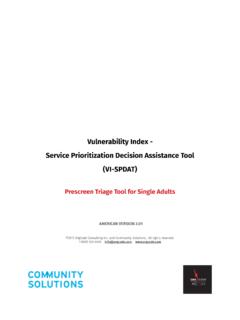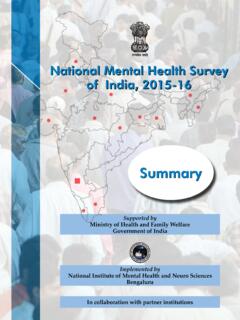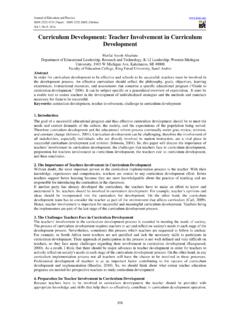Transcription of Characteristics of HEALTHY Romantic Relationships
1 Characteristics of a HEALTHY , Functional Romantic relationship A HEALTHY functional intimate relationship is based on equality and respect, not power and control. Think about how you treat (and want to be treated by) someone you care about. Compare the Characteristics of a HEALTHY functional Romantic relationship with those of an unhealthy dysfunctional Romantic relationship . Honesty & Accountability: Accepting responsibility for self, acknowledging past use of violence, admitting when you are wrong, communicating openly and honestly, keeping your word, not making excuses for your partner s or for your own actions.
2 relationship is built on truth rather than game playing. Open Communication: Being able to express your feelings or opinions, knowing it is okay to disagree, saying what you mean and meaning what you say. Communication is based on clarifying issues, specifying feelings, and working together for mutually satisfying solutions. If one partner does something that hurts the other in any way they take responsibility, and make needed changes in their demonstration of love for the other partner. Negotiation & Fairness: Seeking mutually satisfying resolutions to conflict, being willing to find solutions that are agreeable to both people.
3 Acknowledging your wants & needs are just as valid as your partner s (you don t have to agree in order to respect your partner and to understand differences in opinion). When differences come up, try to see the situation from your partner s point of view and try to work through them together (agreeing to disagree sometimes, willing to compromise). No issue or problem is more important than the relationship winning the argument is seen as harming the relationship . Economic Partnership: Making money decisions together, making sure both partners benefit from financial arrangements, sharing dating expenses, accepting both partners need to hold a job.
4 Shared Responsibility: Making decisions together, splitting or alternating costs on dates. Being mindful of the other person s needs as well as your own - doing things for each other, going places you both enjoy, giving as much as you receive. Shared Power: In general, each person has an equal say in the relationship , although at time, one person may have greater say because of more information or experience in an area. Each is mindful of the other s needs and wants (as well as your own). The individuals view themselves as part of a couple that brings each person more happiness & allows each to be stronger.
5 Respect: Each person is valued for who they are and what they bring to the relationship . Treat the other person as if he/she is of value. Find ways to appreciate them for who they are. Differences in thoughts, feelings, values, etc. are accepted and respected. Accept your partner for who they are. Do not demand that the other person change to meet all your expectations. Paying attention to your partner, valuing your partner s opinion even if it differs from yours, listening to what your partner has to say, listening to her non-judgmentally, being emotionally affirming & understanding.
6 Violence is not used by either partner. Trust & Support: Being supportive, wanting the best for your partner, knowing your partner likes you, being able to rely on your partner, offering encouragement when necessary, being okay with your partner having different friends. The couple feels secure sharing private aspects of each other s thoughts & feelings - since couple feels secure there is no jealousy or possessiveness. Individuals can let their barriers down and allow the other person to see their perceived weaknesses, without fear of negative reactions from them.
7 Individuals are able to be open to what the other person is feeling. Non-Threatening Behavior: Talking and acting so that each person feels safe & comfortable expressing her/himself and doing things Intimacy: Respecting your partner s boundaries, respecting each other s privacy, not pressuring your partner, being faithful. Physical Affection: Holding hands, hugging, kissing, sitting with your arm on your partner s shoulder. Respecting each other s right to say no, asking before acting. Personal Integrity: Partners are able to maintain beliefs and sense of self as well as offer time & attention to the relationship .
8 Partners have some independence & privacy and care about each other s quality of life. Working on a relationship always begins with working on ourselves; take responsibility for our behavior (be accountable). Basic Steps to Maintaining a Good, HEALTHY relationship Be aware of what you and your partner want for yourselves and what you want from the relationship . Let one another know what your needs are & be able to communicate them assertively. You aren t psychic & neither is he/she. Realize that your partner will not be able to meet all of your needs - some needs will be met outside of the relationship .
9 Do not demand that a partner change to meet all your expectations. Work to accept differences that you see between your ideal (how you would like things to be) & the reality (how they really are). Expect conflict - be willing to negotiate & compromise on the things you want from one another. Perspective-taking & empathy - try to see things from the other s point of view and to accept them. You don t have to agree to respect and understand differences. Realize that HEALTHY Relationships take continual work and effort to maintain. When differences come up, try to negotiate.
10 HEALTHY Romantic Relationships Here are a few of the factors to consider as you take your relationship temperature: How well do you and your partner listen to each other? When you and your partner talk, do you look each other in the eye and really hear what you are each saying, or is one of you already planning a response before the other has finished talking? How willing are you to take responsibility for your role in your relationship ? Most people are good at finding fault in others; particularly those with whom they are in relationship .










